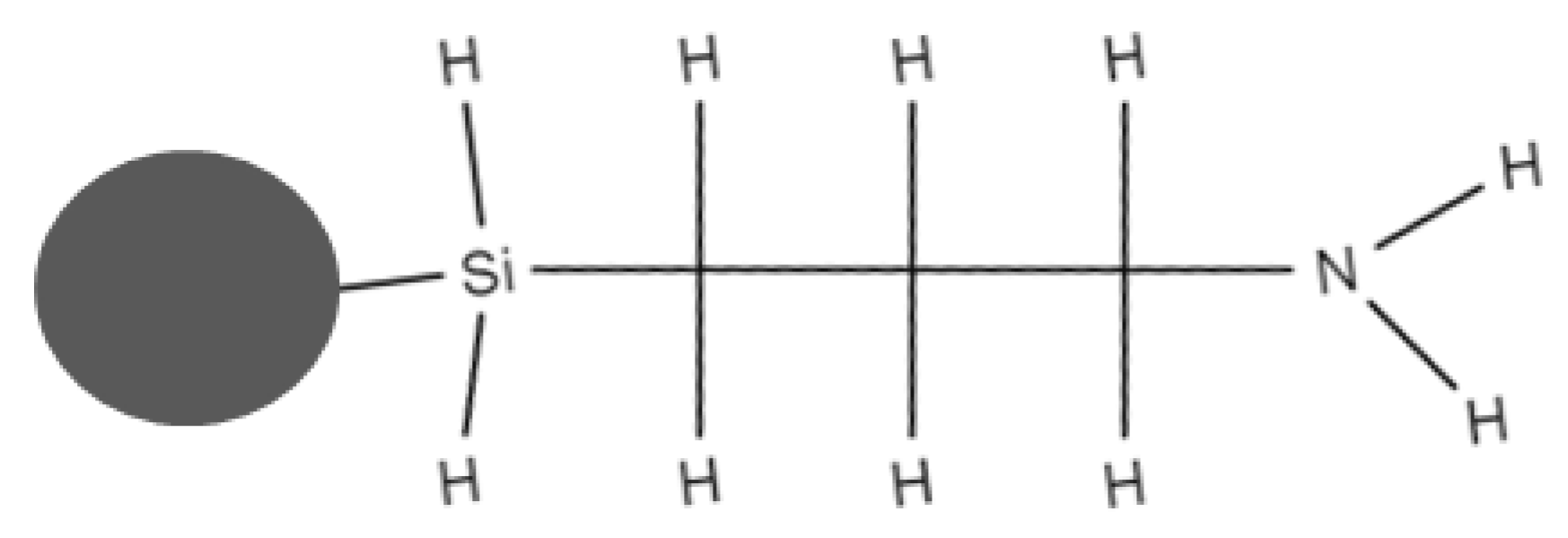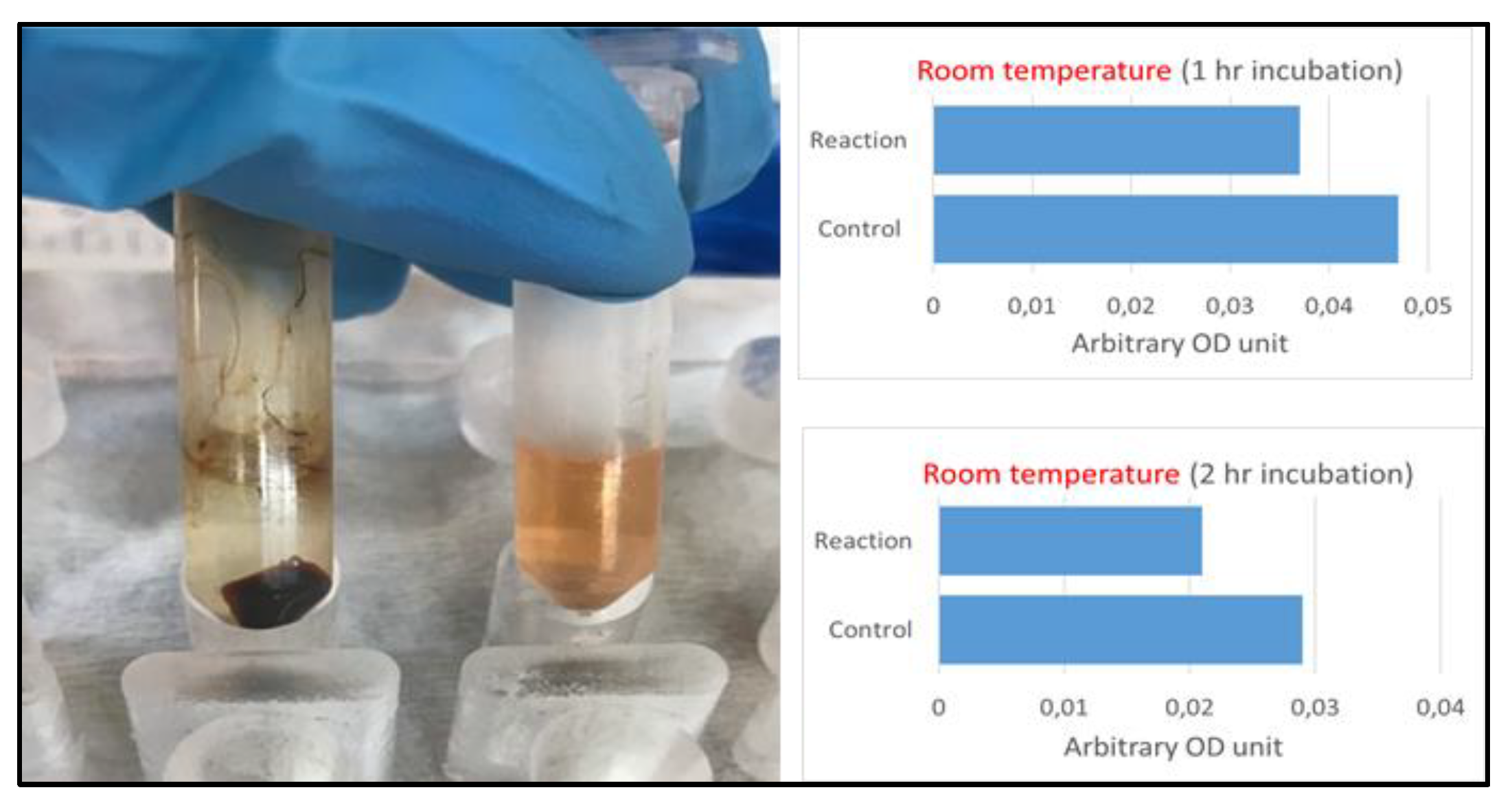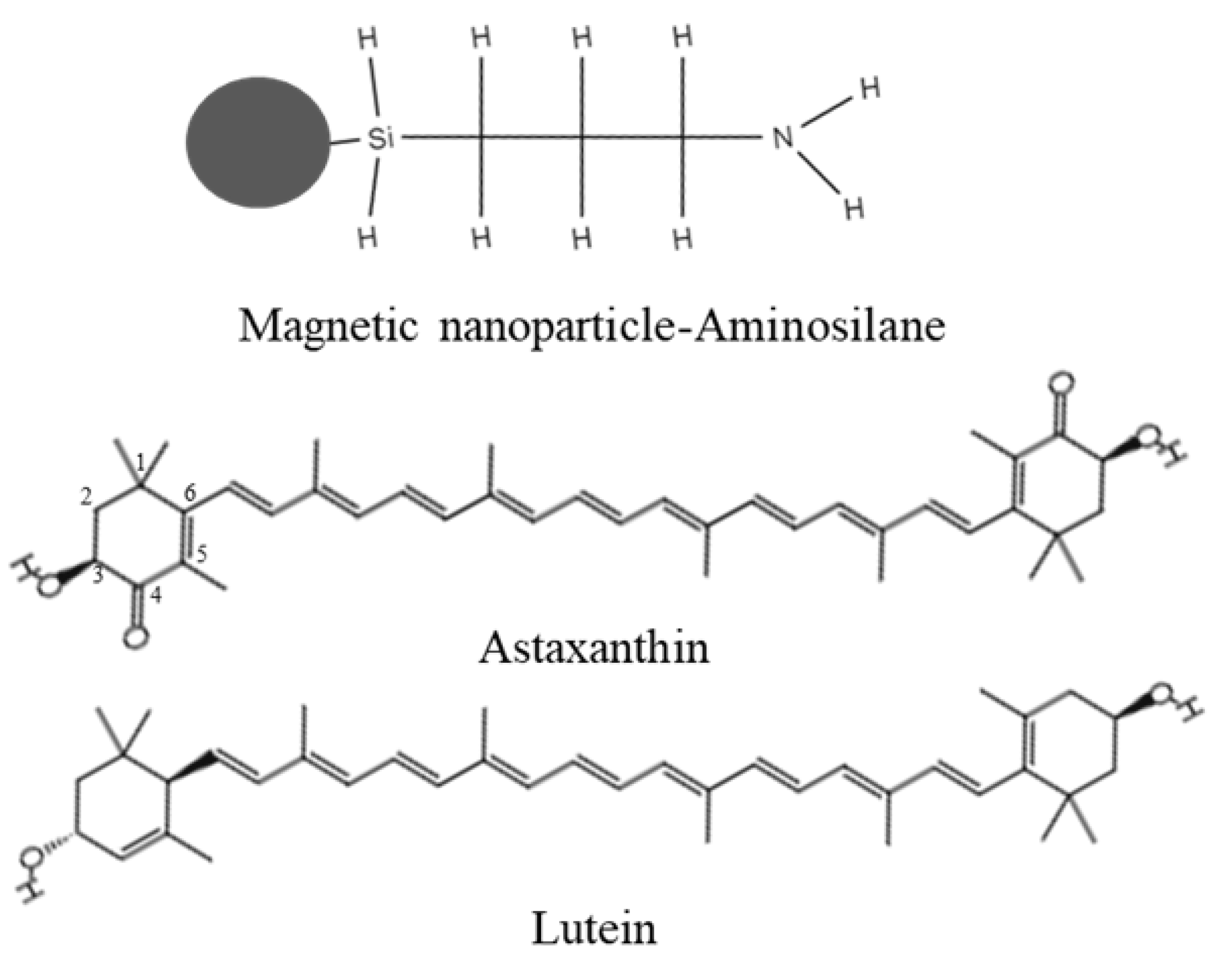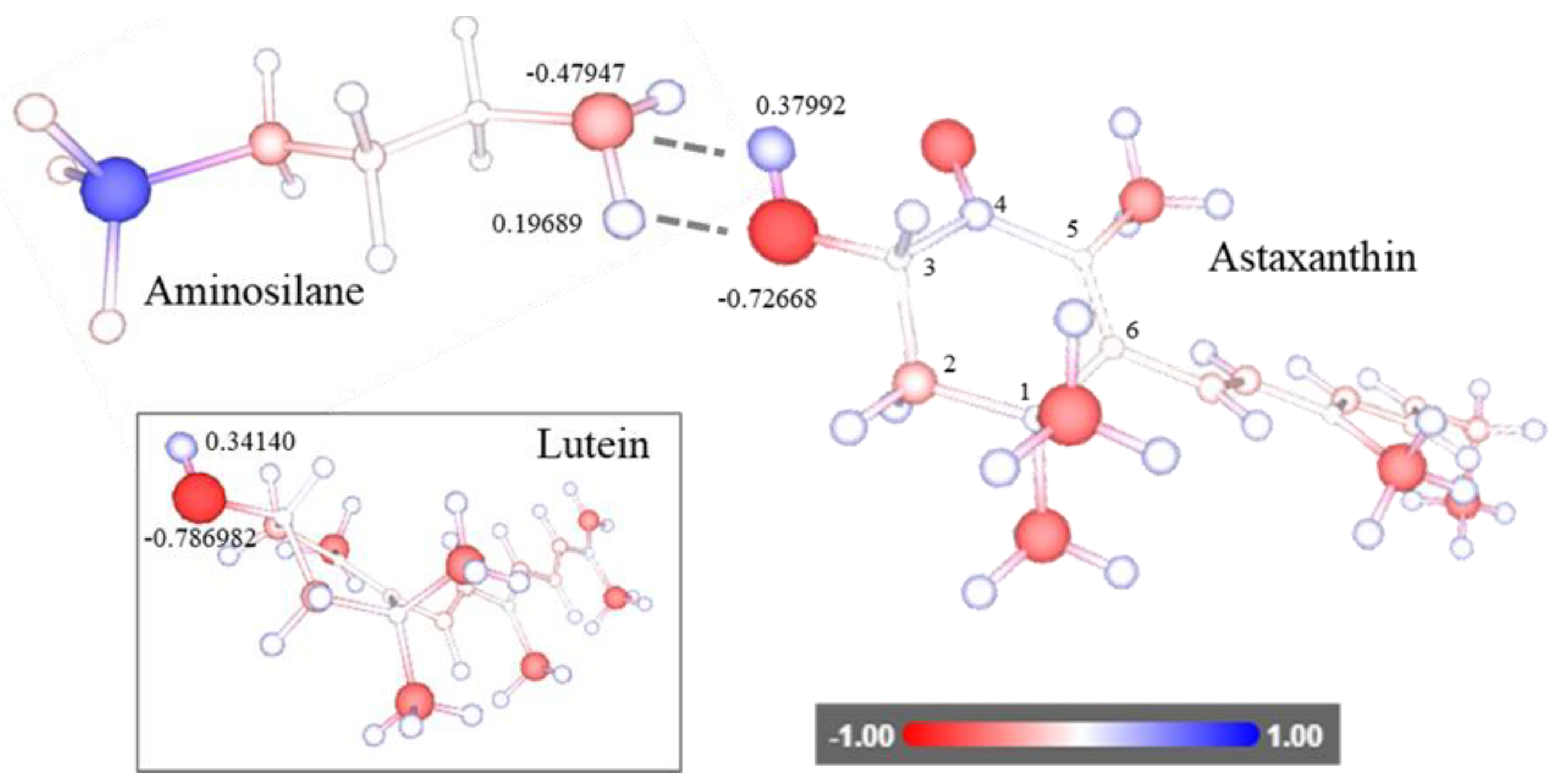Separation and Concentration of Astaxanthin and Lutein from Microalgae Liquid Extracts Using Magnetic Nanoparticles
Abstract
:1. Introduction
2. Materials and Methods
2.1. Microalgae Extracts
2.2. Magnetic Nanoparticles
2.3. Reagents and Standards for Liquid Chromatography-Mass Spectrometry
2.4. Liquid Chromatography-Tandem Mass Spectrometry (LC-MS/MS) Analysis
2.5. Saturation of FluidMAG-Amine with Astaxanthin
2.6. Software for Structural Analysis
3. Results
3.1. Effect of Temperature, Magnetic Nanoparticles Concentration and Elution Time on Commercial Astaxanthin Recovery from Solution
3.2. Magnetic Separation of Astaxanthin from H. pluvialis Extracts
3.3. Carotenoids Purity Analysis after Magnetic Separation
4. Discussion
5. Conclusions
Author Contributions
Funding
Institutional Review Board Statement
Informed Consent Statement
Data Availability Statement
Conflicts of Interest
References
- Safarik, I.; Safarikova, M. Magnetic techniques for the isolation and purification of proteins and peptides. Biomagn. Res. Technol. 2004, 2, 7. [Google Scholar] [CrossRef] [Green Version]
- Kim, S.-E.; Van Tieu, M.; Hwang, S.Y.; Lee, M.-H. Magnetic Particles: Their Applications from Sample Preparations to Biosensing Platforms. Micromachines 2020, 11, 302. [Google Scholar] [CrossRef] [Green Version]
- Plouffe, B.; Murthy, S.K.; Lewis, L.H. Fundamentals and application of magnetic particles in cell isolation and enrichment: A review. Rep. Prog. Phys. 2014, 78, 016601. [Google Scholar] [CrossRef]
- Almomani, F. Algal cells harvesting using cost-effective magnetic nano-particles. Sci. Total Environ. 2020, 720, 137621. [Google Scholar] [CrossRef]
- Safarik, I.; Pospiskova, K.; Baldikova, E.; Safarikova, M. Magnetic particles for microalgae separation and biotechnology. In Food Bioactives; Springer: Cham, Switzerland, 2017; pp. 153–169. [Google Scholar]
- Ge, S.; Agbakpe, M.; Zhang, W.; Kuang, L.; Wu, Z.; Wang, X. Recovering magnetic Fe3O4–ZnO nanocomposites from algal biomass based on hydrophobicity shift under UV irradiation. ACS Appl. Mater. Interfaces 2015, 7, 11677–11682. [Google Scholar] [CrossRef]
- Bruce, I.J.; Davies, M.J.; Howard, K.; Smethurst, D.E.; Todd, M. Magnetizable Solid-phase Supports for Purification of Nucleic Acids. J. Pharm. Pharmacol. 1996, 48, 147–149. [Google Scholar] [CrossRef]
- I Taylor, J.; Hurst, C.D.; Davies, M.J.; Sachsinger, N.; Bruce, I.J. Application of magnetite and silica–magnetite composites to the isolation of genomic DNA. J. Chromatogr. A 2000, 890, 159–166. [Google Scholar] [CrossRef]
- Matsunaga, T.; Nakayama, H.; Okochi, M.; Takeyama, H. Fluorescent detection of cyanobacterial DNA using bacterial magnetic particles on a MAG-microarray. Biotechnol. Bioeng. 2001, 73, 400–405. [Google Scholar] [CrossRef]
- Rudi, K.; Kroken, M.; Dahlberg, O.; Deggerdal, A.; Jakobsen, K.; Larsen, F. Rapid, Universal Method to Isolate PCR-Ready DNA Using Magnetic Beads. BioTechniques 1997, 22, 506–511. [Google Scholar] [CrossRef] [PubMed]
- Cano, M.; Sbargoud, K.; Allard, E.; Larpent, C. Magnetic separation of fatty acids with iron oxide nanoparticles and application to extractive deacidification of vegetable oils. Green Chem. 2012, 14, 1786–1795. [Google Scholar] [CrossRef]
- Rozhina, E.; Danilushkina, A.; Akhatova, F.; Fakhrullin, R.; Rozhin, A.; Batasheva, S. Biocompatibility of magnetic nanoparticles coating with polycations using A549 cells. J. Biotechnol. 2020, 325, 25–34. [Google Scholar] [CrossRef] [PubMed]
- Ishmukhametov, I.; Batasheva, S.; Rozhina, E.; Akhatova, F.; Mingaleeva, R.; Rozhin, A.; Fakhrullin, R. DNA/Magnetic Nanoparticles Composite to Attenuate Glass Surface Nanotopography for Enhanced Mesenchymal Stem Cell Differentiation. Polymers 2022, 14, 344. [Google Scholar] [CrossRef] [PubMed]
- Ventura, S.; Nobre, B.; Ertekin, F.; Hayes, M.; Garciá-Vaquero, M.; Vieira, F.; Koc, M.; Gouveia, L.; Aires-Barros, M.; Palavra, A. Extraction of value-added compounds from microalgae. In Microalgae-Based Biofuels and Bioproducts; Elsevier: Amsterdam, The Netherlands, 2017; pp. 461–483. [Google Scholar]
- Levasseur, W.; Perré, P.; Pozzobon, V. A review of high value-added molecules production by microalgae in light of the classification. Biotechnol. Adv. 2020, 41, 107545. [Google Scholar] [CrossRef] [PubMed]
- Dhan Prakash, D.P.; Charu Gupta, C.G. Carotenoids: Chemistry and health benefits. In Phytochemicals of Nutraceutical Importance; CABI: Wallingford, UK, 2014; pp. 181–195. [Google Scholar] [CrossRef]
- Jaime, L.-C.; Sánchez-Machado, D.I. Astaxanthin, lutein, and zeaxanthin. In Nonvitamin and Nonmineral Nutritional Supplements; Academic Press: Cambridge, MA, USA, 2019; pp. 19–25. [Google Scholar]
- Hosokawa, M.; Wanezaki, S.; Miyauchi, K.; Kurihara, H.; Kohno, H.; Kawabata, J.; Odashima, S.; Takahashi, K. Apoptosis-Inducing Effect of Fucoxanthin on Human Leukemia Cell Line HL-60. Food Sci. Technol. Res. 1999, 5, 243–246. [Google Scholar] [CrossRef] [Green Version]
- Guedes, A.C.; Gião, M.S.; Matias, A.A.; Nunes, A.V.; Pintado, M.E.; Duarte, C.M.; Malcata, F.X. Supercritical fluid extraction of carotenoids and chlorophylls a, b and c, from a wild strain of Scenedesmus obliquus for use in food processing. J. Food Eng. 2013, 116, 478–482. [Google Scholar] [CrossRef] [Green Version]
- Wijesinghe, W.; Jeon, Y.-J. Enzyme-assistant extraction (EAE) of bioactive components: A useful approach for recovery of industrially important metabolites from seaweeds: A review. Fitoterapia 2012, 83, 6–12. [Google Scholar] [CrossRef]
- Molino, A.; Rimauro, J.; Casella, P.; Cerbone, A.; Larocca, V.; Chianese, S.; Karatza, D.; Mehariya, S.; Ferraro, A.; Hristoforou, E.; et al. Extraction of astaxanthin from microalga Haematococcus pluvialis in red phase by using generally recognized as safe solvents and accelerated extraction. J. Biotechnol. 2018, 283, 51–61. [Google Scholar] [CrossRef]
- Molino, A.; Mehariya, S.; Iovine, A.; Larocca, V.; Di Sanzo, G.; Martino, M.; Casella, P.; Chianese, S.; Musmarra, D. Extraction of Astaxanthin and Lutein from Microalga Haematococcus pluvialis in the Red Phase Using CO2 Supercritical Fluid Extraction Technology with Ethanol as Co-Solvent. Mar. Drugs 2018, 16, 432. [Google Scholar] [CrossRef] [Green Version]
- Furr, H.C. Analysis of Retinoids and Carotenoids: Problems Resolved and Unsolved. J. Nutr. 2004, 134, 281S–285S. [Google Scholar] [CrossRef]
- Petry, F.C.; Mercadante, A.Z. New method for carotenoid extraction and analysis by HPLC-DAD-MS/MS in freeze-dried citrus and mango pulps. J. Braz. Chem. Soc. 2018, 29, 205–215. [Google Scholar] [CrossRef]
- Butnariu, M. Methods of Analysis (Extraction, Separation, Identification and Quantification) of Carotenoids from Natural Products. J. Ecosyst. Ecography 2016, 6, 193. [Google Scholar] [CrossRef]
- Tsiaka, T.; Fotakis, C.; Lantzouraki, D.; Tsiantas, K.; Siapi, E.; Sinanoglou, V.; Zoumpoulakis, P. Expanding the Role of Sub-Exploited DOE-High Energy Extraction and Metabolomic Profiling towards Agro-Byproduct Valorization: The Case of Carotenoid-Rich Apricot Pulp. Molecules 2020, 25, 2702. [Google Scholar] [CrossRef] [PubMed]
- Rivera, S.M.; Vilaró, F.; Zhu, C.; Bai, C.; Farré, G.; Christou, P.; Canela-Garayoa, R. Fast Quantitative Method for the Analysis of Carotenoids in Transgenic Maize. J. Agric. Food Chem. 2013, 61, 5279–5285. [Google Scholar] [CrossRef]
- Van Breemen, R.B.; Dong, L.; Pajkovic, N.D. Atmospheric pressure chemical ionization tandem mass spectrometry of carotenoids. Int. J. Mass Spectrom. 2012, 312, 163–172. [Google Scholar] [CrossRef] [PubMed] [Green Version]
- Ionescu, C.-M.; Sehnal, D.; Falginella, F.L.; Pant, P.; Pravda, L.; Bouchal, T.; Vařeková, R.S.; Geidl, S.; Koča, J. AtomicChargeCalculator: Interactive web-based calculation of atomic charges in large biomolecular complexes and drug-like molecules. J. Cheminform. 2015, 7, 50. [Google Scholar] [CrossRef] [PubMed] [Green Version]
- Abraham, J. International conference on harmonisation of technical requirements for registration of pharmaceuticals for human use. In Handbook of Transnational Economic Governance Regimes; Brill Nijhoff: Leiden, The Netherlands, 2010; pp. 1041–1053. [Google Scholar]
- Brotosudarmo, T.H.P.; Limantara, L.; Setiyono, E. Structures of Astaxanthin and Their Consequences for Therapeutic Application. Int. J. Food Sci. 2020, 2020, 2156582. [Google Scholar] [CrossRef]
- Humphries, J.M.; Khachik, F. Distribution of Lutein, Zeaxanthin, and Related Geometrical Isomers in Fruit, Vegetables, Wheat, and Pasta Products. J. Agric. Food Chem. 2003, 51, 1322–1327. [Google Scholar] [CrossRef]
- Todorović, B.; Grujić, V.J.; Krajnc, A.U.; Kranvogl, R.; Ambrožič-Dolinšek, J. Identification and Content of Astaxanthin and Its Esters from Microalgae Haematococcus pluvialis by HPLC-DAD and LC-QTOF-MS after Extraction with Various Solvents. Plants 2021, 10, 2413. [Google Scholar] [CrossRef]
- Ullah, Z.; Ali, S.; Hussain, A.; Öztürk, M.; Ertaş, A.; Alamzeb, M.; Rashid, M.U.; Ullah, H.; Zaman, R.; Imtiaz, M. In vitro antioxidant, anticholinesterase, tyrosinase activity studies, and LC-MS/MS simultaneous determination of 37 bioactive compounds in Indigofera heterantha. S. Afr. J. Bot. 2022, 148, 537–545. [Google Scholar] [CrossRef]
- Zhang, L.; Wang, S.; Yang, R.; Mao, J.; Jiang, J.; Wang, X.; Zhang, W.; Zhang, Q.; Li, P. Simultaneous determination of tocopherols, carotenoids and phytosterols in edible vegetable oil by ultrasound-assisted saponification, LLE and LC-MS/MS. Food Chem. 2019, 289, 313–319. [Google Scholar] [CrossRef]
- Craft, N.E. Chromatographic Techniques for Carotenoid Separation. Curr. Protoc. Food Anal. Chem. 2001, F2.3.1–F2.3.15. [Google Scholar] [CrossRef]
- Aman, R.; Carle, R.; Conrad, J.; Beifuss, U.; Schieber, A. Isolation of carotenoids from plant materials and dietary supplements by high-speed counter-current chromatography. J. Chromatogr. A 2005, 1074, 99–105. [Google Scholar] [CrossRef]
- Cuellar-Bermudez, S.P.; Aguilar-Hernandez, I.; Cardenas-Chavez, D.L.; Ornelas-Soto, N.; Romero-Ogawa, M.A.; Parra-Saldivar, R. Extraction and purification of high-value metabolites from microalgae: Essential lipids, astaxanthin and phycobiliproteins. Microb. Biotechnol. 2015, 8, 190–209. [Google Scholar] [CrossRef] [PubMed]
- Fujii, K. Process integration of supercritical carbon dioxide extraction and acid treatment for astaxanthin extraction from a vegetative microalga. Food Bioprod. Process. 2012, 90, 762–766. [Google Scholar] [CrossRef]
- Savvidou, M.; Dardavila, M.; Georgiopoulou, I.; Louli, V.; Stamatis, H.; Kekos, D.; Voutsas, E. Optimization of Microalga Chlorella vulgaris Magnetic Harvesting. Nanomaterials 2021, 11, 1614. [Google Scholar] [CrossRef] [PubMed]
- Savvidou, M.G.; Ferraro, A.; Schinas, P.; Mamma, D.; Kekos, D.; Hristoforou, E.; Kolisis, F.N. Magnetic Immobilization and Growth of Nannochloropsis oceanica and Scenedasmus almeriensis. Plants 2021, 11, 72. [Google Scholar] [CrossRef] [PubMed]







| mg/g H. Pluvialis Biomass | mg/g Extracts | Recovery % | |
|---|---|---|---|
| Moisture | 2.79 | 0 | |
| Ash | 40.2 | 1.58 | 3.93 |
| β-carotene | 0.99 | 2.5 | 50.0 |
| Astaxanthin | 20 | 45.85 | 48.20 |
| Lutein | 7.7 | 10.05 | 26.00 |
| Proteins | 256.7 | 122.61 | 47.76 |
| Carbohydrates | 63 | 0.36 | 0.57 |
| Total Dietary Fibers | 585.2 | 39.8 | 6.80 |
| Lipids | 26 | 17.39 | 66.88 |
| Carotenoids | Retention Time, RT (Minutes) | Collision Energy (eV) | Parent Ion (m/z) [M + H]+ | Product Ion Used for Carotenoid Determination (m/z) |
|---|---|---|---|---|
| Astaxanthin | 3.24 | 40 | 597.4 | 579.3 |
| Lutein | 3.82 | 35 | 551.4 | 533.3 |
| Carotenoids | Control Sample | S1 Sample | S2 Sample |
|---|---|---|---|
| Astaxanthin (mg/mL) (±stdev) | 0.06944 (±0.00039) c | 0.1617 (±0.0028) a | 0.1424 (±0.0015) b |
| Lutein (mg/mL) (±stdev) | 0.17123 (±0.00035) c | 0.36852 (±0.00018) a | 0.3326 (±0.0011) b |
Publisher’s Note: MDPI stays neutral with regard to jurisdictional claims in published maps and institutional affiliations. |
© 2022 by the authors. Licensee MDPI, Basel, Switzerland. This article is an open access article distributed under the terms and conditions of the Creative Commons Attribution (CC BY) license (https://creativecommons.org/licenses/by/4.0/).
Share and Cite
Savvidou, M.G.; Tsiaka, T.; Zoumpoulakis, P.; Maggiorou, E.; Tyrovolas, K.; Molino, A.; Hristoforou, E.; Ferraro, A. Separation and Concentration of Astaxanthin and Lutein from Microalgae Liquid Extracts Using Magnetic Nanoparticles. Magnetochemistry 2022, 8, 80. https://doi.org/10.3390/magnetochemistry8080080
Savvidou MG, Tsiaka T, Zoumpoulakis P, Maggiorou E, Tyrovolas K, Molino A, Hristoforou E, Ferraro A. Separation and Concentration of Astaxanthin and Lutein from Microalgae Liquid Extracts Using Magnetic Nanoparticles. Magnetochemistry. 2022; 8(8):80. https://doi.org/10.3390/magnetochemistry8080080
Chicago/Turabian StyleSavvidou, Maria G., Thalia Tsiaka, Panagiotis Zoumpoulakis, Emanouella Maggiorou, Konstantinos Tyrovolas, Antonio Molino, Evangelos Hristoforou, and Angelo Ferraro. 2022. "Separation and Concentration of Astaxanthin and Lutein from Microalgae Liquid Extracts Using Magnetic Nanoparticles" Magnetochemistry 8, no. 8: 80. https://doi.org/10.3390/magnetochemistry8080080









